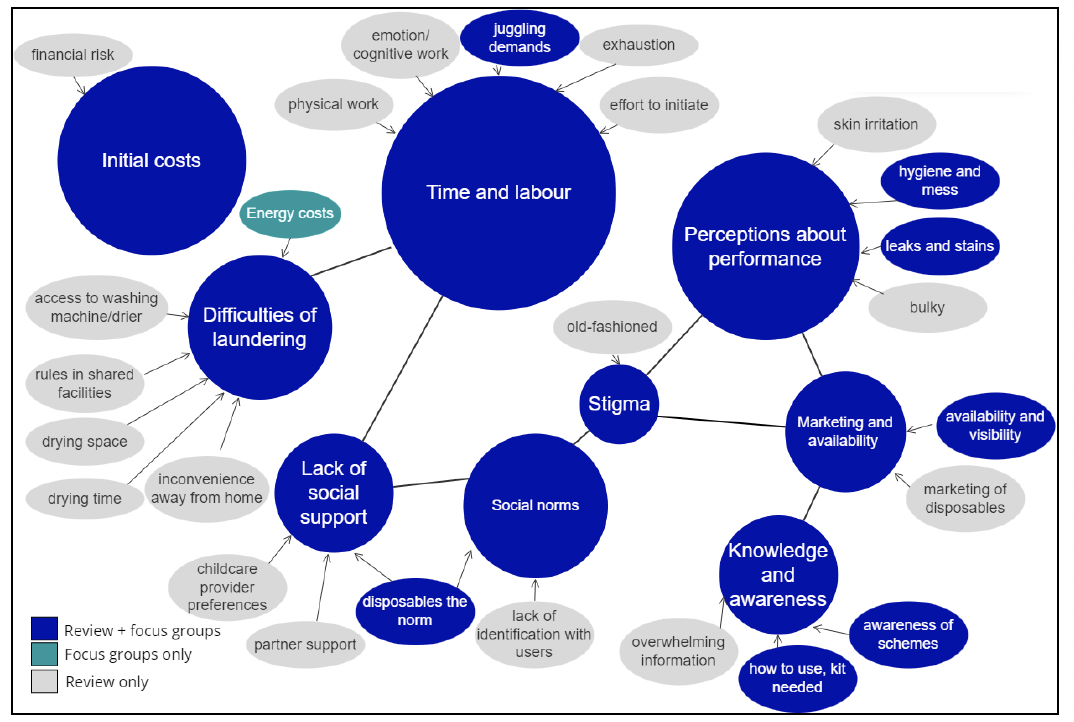Reusable nappies: research
Provides commentary on a range of motivations and barriers associated with reusable nappies and makes a number of recommendations to encourage increased uptake among families in Scotland.
Executive Summary
Introduction
Disposable nappies, composed of plastics and mixed materials, consume resources and pose challenges for waste management in Scotland. At the same time, families spend considerable sums of money on disposable nappies in the early years of a child’s life. Modern reusable nappies offer an alternative option to disposables, however uptake of reusables is currently low. This research report, commissioned in support of The Scottish Government’s Circular Economy and Waste Route Map to 2030, provides evidence to inform future policy action to encourage a sustained increase in the use of reusable nappies in Scotland.
Research objectives:
1) Develop a thorough understanding of the behaviours and motivations of families around nappy choices, both what encourages and prevents them from using reusable nappies.
2) Understand the overall impacts of schemes to increase reusable nappies.
Methods
The research comprised a Rapid Evidence Assessment of academic and grey literature, supplemented by identification of existing schemes to support use of reusable nappies in Scotland, alongside in-depth qualitative research in the form of focus groups with parents of children aged 0-5 years.
Key Findings: Barriers and motivations to adoption of reusable nappies
- Disposables are seen as a default – Strong social norms favouring disposable nappies mean that many parents do not even consider that there is a choice to be made when it comes to nappies.
- Drivers of uptake of reusables centre on environmental impacts, costs and babies’ health – Motivations for adopting reusables, reported in the evidence review (see Figure A overleaf) and in the focus groups centre around reducing environmental impact, achieving cost savings and reducing babies’ exposure to chemicals associated with disposable nappies. While environmental concerns are emphasised in published evidence, our focus groups found cost savings to be more prominent in the minds of participants who already use/have used reusables.
- Barriers to the adoption of reusable nappies are numerous and may be compounded for certain groups – A wide range of interconnected barriers were highlighted in the evidence review (see Figure B overleaf). Time and labour involved in washing and drying reusable nappies feature strongly and the literature highlights the often gendered nature of this work. While the initial cost outlay is a particular concern for low income families, focus groups also highlighted concerns around the costs of laundering and associated heating costs when drying indoors. For focus group participants that predominantly used disposables, financial considerations were more often a barrier than a motivation for using reusables.


* Bubbles sized to give indication of prominence across studies reviewed (not to scale)
Key Findings: Schemes to support and encourage use of reusable nappies
- There is a limited evidence base on the effectiveness of reusable nappy schemes or interventions – The evidence review highlighted a range of scheme types, however evidence on the impacts of each scheme type was limited, with studies often suffering from poor quality research designs or lack of necessary information provided to judge the accuracy of reported impacts.
- There are examples in the literature which point to potentially promising interventions for supporting greater uptake of reusables, however more research is needed – The evidence review highlights reusable nappy kit provision, nappy laundry services, and financial incentives such as voucher schemes as of potential value in increasing adoption. At the same time, however, focus groups suggested that nappy laundry services in particular may be unappealing to many parents.
- There are a range of schemes operating in Scotland, but very little available evidence evaluating their impacts – Our preliminary mapping of local and regional Scottish schemes highlighted established networks of nappy libraries run by charities and community organisations. Some examples of reusable nappy kit provision schemes and cashback/grant schemes, operated by or in partnership with local authorities, were also identified.
Recommendations
Based on the findings of the rapid evidence assessment and focus groups, we propose the following recommendations for future policy development and practical action to increase adoption of reusable nappies in Scotland. These are expanded on in greater detail in the report.
1. Work with parents to develop policy options that take into account the experiences of diverse groups of parents.
2. Support the development of the evidence base on reusable nappy schemes through trials/pilot projects with robust evaluation built in.
3. Develop a Scotland-specific Life Cycle Assessment to tailor estimations of scheme or policy impacts to the Scottish context.
4. Increase the visibility of reusable nappies in health services, shops and the media, through early and repeated exposure in pregnancy and beyond and supporting opportunities for hands on experience.
5. Avoid setting reusables against disposables; many parents find reusables more manageable when used in combination with disposables.
6. Address gender inequalities in nappy care work by engaging dads in nappy choices and laundering of reusables.
Contact
There is a problem
Thanks for your feedback